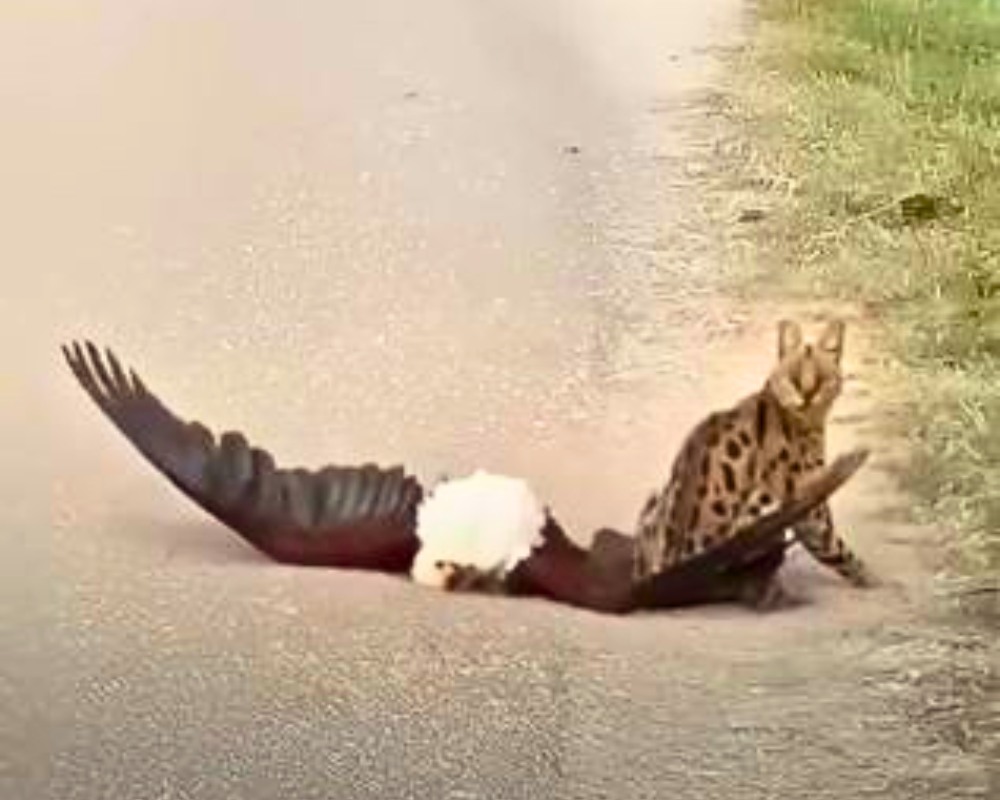A bald eagle tried to grab a wild cat. The plan failed. The scene shows how bald eagle hunts can go wrong in real life nature. The clip also reminds us that every animal fight carries risk for both sides.
What the video shows
Witnesses saw an eagle swoop low at a small cat-sized predator. The bird hit the ground, wings spread, talons forward, aiming for a fast pin. Instead of a clean catch, the eagle ended up on its belly, struggling to keep a grip while the cat kicked and twisted free. For several seconds the eagle could not launch. That is rare but not impossible. Ground grapples are the worst place for a raptor to be. The cat’s claws and teeth are built for close contact. In nature, close contact favors the mammal.
Why a bald eagle would target a cat
Bald eagles are opportunistic. Fish is their main food where water is nearby. They also take waterfowl, rabbits, squirrels, and carrion. In lean moments they test small mammals. A cat-sized quarry can look like an easy win from the air. The eagle sees a moving animal in the open and commits. But the risk is real. A single deep cut to the wing, leg, or toe can end an eagle’s hunting season.
The strength-and-risk equation
Raptors win by surprise and position, not by long wrestling matches. Talons are strong and sharp, yet leverage matters. If the eagle lands off-center or the prey rolls under the body, the talons cannot close on the spine or neck. Then the bird must either readjust or release. On flat ground the cat can twist to face the bird. The cat can use its rear legs to rake. That forces the eagle to protect its eyes and pull back its head. The longer the grapple, the higher the risk for both animals.
How the cat turned the fight
Cats, wild or feral, are fast in short bursts. They also have flexible spines that help them spin under pressure. In the clip the cat stayed low, kept kicking, and never let the eagle settle. The eagle could not get lift because the wings needed space to pump air. Each time the eagle tried to open its wings, the cat surged in. The result looked like a stalemate on the ground until the bird disengaged.
Related read: Full Story: https://aquariumbee.com/man-loses-360-pounds-naturally-internet-rallies-to-support-his-next-step/
What likely happened next
Most such encounters end with separation. The eagle backs off to save its wings. The cat sprints to cover. Both survive, but both burn energy and risk injury. Even if the eagle “wins,” carrying a heavy, struggling animal can be impossible. Raptors can lift only so much while keeping wings clear and balanced. A bad carry can cause a crash. Letting go is often the safer choice.
Predator-prey lessons from this moment
-
Ambush beats brawl. Raptors want a clean lock, then a lift. Ground fights are a last resort.
-
Prey fights hard. Many small mammals have tools that punish close-range mistakes.
-
Not every hunt ends in a kill. In wild nature, failure and retreat are common and sensible.
-
Energy matters. A failed hunt costs time and calories. Both sides seek the fastest exit once odds worsen.
Safety and ethics for people who witness such events
-
Do not intervene. Wild animals must resolve wild interactions.
-
Keep children and pets away. Give the raptor space to escape.
-
Do not chase or crowd for a better video. Stress increases injury risk.
-
If either animal is clearly injured and cannot move, contact local wildlife rescue. Follow their guidance.
Could the “wild cat” be a bobcat or a feral cat?
Without clear ID, both are possible. Bobcats are native in many regions and are skilled fighters. Feral or free-roaming domestic cats can also defend themselves and deliver serious cuts. In either case the behavior in the video fits a small predator that refuses to be pinned and uses kicks, bites, and spins to break a raptor’s grip.
Why raptors sometimes “play dead” or look flattened
Observers often think the eagle looks “flattened” or “defeated.” What you see is defensive posture. The bird spreads its body to shield its legs and chest. It keeps the head high and the bill ready. If a clear opening appears, it will hop-step to space and launch. That requires a gap to open the wings. Until then, the safest move is to stay low and block.
What this means for backyard wildlife
-
Keep cats indoors or supervise outdoor time. It protects songbirds and reduces risky encounters.
-
Remove attractants that pull both predators and prey to the same spot, like open trash or exposed feed.
-
If you live near water, expect eagles to patrol. They key on fish first, but will test any easy meal.
-
Use motion lights sparingly. Sudden light can startle both species and trigger chaotic chases.
FAQs
Do bald eagles often attack cats?
It is uncommon. Fish and water birds are preferred. But eagles test opportunities. If a small animal moves in the open and looks vulnerable, a raptor may try.
Can an eagle carry off a heavy cat?
Large, struggling prey are hard to carry. Lift depends on size, wind, and how the talons are set. Many attempts end with a drop or a quick release.
Did either animal get hurt here?
From the description, both separated without clear harm. Even so, minor wounds can occur. That is normal in wild nature.
Why didn’t the eagle fly away sooner?
It needed space to open its wings. With a cat under its body, the wings risk damage if they strike the ground or the prey.
What should I do if I see this near my home?
Keep distance. Bring pets inside. Let the encounter end on its own. Call wildlife rehab only if an animal is clearly immobile or injured.
Key takeaways
-
A bald eagle failed to capture a wild cat after a ground grapple.
-
Close-quarters fights favor the mammal; raptors prefer surprise and quick lift.
-
Not all hunts end in a kill. Energy and injury risk drive fast retreats.
-
People should observe, not intervene, and manage pets to reduce conflict.
Further reading: Full Story: https://aquariumbee.com/the-hidden-meaning-behind-princess-dianas-cannes-gown-a-heartfelt-farewell-to-grace-kelly/



